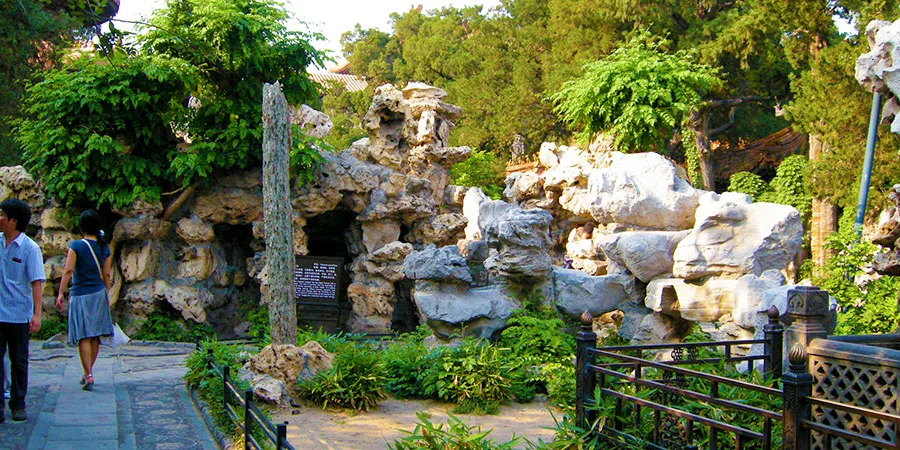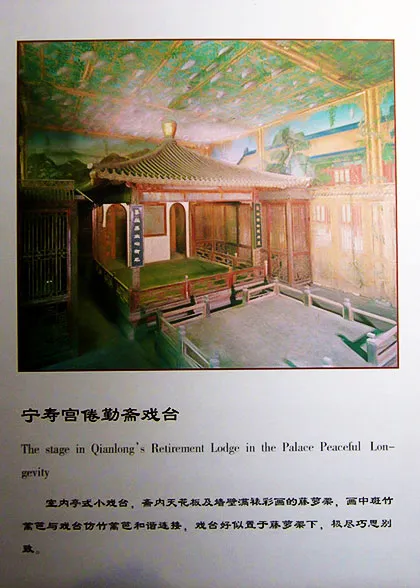Qianlong Garden
Qianlong Garden is located at the northwest part of the Palace of Tranquil Longevity Area, also called Garden of Palace of Tranquil Longevity (Ningshougong Garden). It spans 160 meters (525 feet) north to south and nearly 40 meters (131 feet) east to west, covering over 6,000 square meters (64,583 square feet).
The garden, designed by Emperor Qianlong between 1772 and 1776 for his retirement, blending his longing for a natural and artistic life of literati and his deep affection for gardens. Boasting five themed courtyards and 27 beautifully named buildings, it showcases his talent and elegant taste. Crafted with precious materials and intricate workmanship, Qianlong Garden is renowned as one of the most luxurious gardens ever created.
In 2017, parts of the garden opened to the public for a short time before it underwent renovations. Visitors can look forward to exploring the first and second courtyards again in September 2025.
The first yard was Emperor Qianlong's spot to unwind with a cup of tea, take a leisurely stroll, or entertain friends after his reign. As you approach, a stone rockery teases you with glimpses of what lies beyond, adding a touch of mystery. Inside, it features jade-white marble railings adorned with bamboo motifs and wooden carvings, along with yellow roofs and glazed tiles adhering to royal specifications.
 Highlighted Buildings
Highlighted Buildings
1. Pavilion of Reward and Refreshment (Xishangting)
This pavilion boasts a 27-meter-long (90-foot-long) stone-carved stream with nine bends. Here, Emperor Qianlong and his friends indulged in the ancient pastime of "Floating Cups on the Winding Stream", where wine cups floated along, stopping in front of guests who then composed poems and took a drink, adding fun and creativity to their gatherings.
2. Bower of Ancient Catalpa (Guhuaxuan, a building of unique architectural highlights and legendaries. Click it to see more.)
Step into the second courtyard, and you'll find a peaceful open space quite different from the diversity of the first courtyard. This area of simplicity is designed for relaxation, centered around Hall of Wish Fulfillment (Suichutang).
 Highlighted Building: Hall of Wish Fulfillment
Highlighted Building: Hall of Wish Fulfillment
Hall of Wish Fulfillment boasts a green glazed tile roof adorned with yellow trim, with five auxiliary rooms on both sides, seamlessly connected to the main structure via covered corridors. The name "Suichu" means "returning to one's original aspirations", reflecting Qianlong's desire for the simplest happiness in retirement.
Nestled in the heart of Qianlong Garden, the third yard is like an "adventure zone". It features a labyrinth of gray stone rockeries, complete with hidden staircases and tunnels, inviting visitors to explore.
 Highlighted Buildings:
Highlighted Buildings:
1. Pavilion of Extended Interest (Yanqulou)
This two-story pavilion offers a unique experience. The lower floor is cleverly concealed behind the rockeries, while the upper floor boasts a gallery for you to admire the rockeries from different views.
2. Pavilion of the Three Friends (Sanyouxuan)
This is a rare asymmetrical hut in the Forbidden City with the roof on one side and sloping on the other. Inside, you'll find patterns of pine, plum blossoms, and bamboo, which in Chinese culture stand for integrity, trustworthiness, and wisdom, the three virtues that a good friend should have.
3. Pavilion of Towering Beauty (Songxiuting)
Perched high on the main peak of the rockeries, this square pavilion gives you a bird's-eye view of the entire garden.
The fourth yard was designed for small banquets and enjoying panoramic views. Here, rockeries, covered walkways, and intricate buildings come together to offer a three-dimensional view that you can't miss.
 Highlighted Building: Pavilion of Expecting Good Omen (Fuwangge)
Highlighted Building: Pavilion of Expecting Good Omen (Fuwangge)
Square in shape, this highest building within the Garden appears to be two-story yet it is three-story. The interior decoration is fairly distinctive. The place was divided dexterously into numerous spaces of varied decoration styles. Chances are that you would get lost visiting it, hence the name "mysterious building". As strolling through the corridor on the third floor, you'll overlook the Forbidden City from various directions, even the sights out of the city walls.
It was used as a banquet venue every 21st day of the last lunar month, when the government ceased working and started the New Year holiday. Emperor Qianlong would treat the nobles and ministers here for their hard work throughout the year.
At the northern end of Qianlong Garden, the fifth yard was Emperor Qianlong's personal retreat for relaxation and enjoying opera performances after he stepped down from the throne.
 Highlighted Building: Studio of Exhaustion from Diligent Service (Juanqinzhai)
Highlighted Building: Studio of Exhaustion from Diligent Service (Juanqinzhai)
Known as the "palace's most precious treasure box", the Studio spans 30 meters (98.4 feet) long and 7 meters (23 feet) wide. The east side is adorned with fancy decorations, featuring jade-inlaid bamboo silk wall cover, two-side embroidered ceilings , and doors and windows framed in precious rosewood. Inside, you'll find several throne-like beds.
Hidden on the west side is a small stage where Emperor Qianlong often enjoyed opera. Surrounding the stage is a stunning 170-square-meter (1830-square-foot) mural showing vines hanging from the ceiling, a courtyard scene with cranes, and distant mountains, giving you a sense of being in a lively fairyland-like garden.
Qianlong Garden, a fascinating mix of the east and the west, retains the classic charm of traditional Chinese architecture and integrates foreign artistic touches and advanced craftsmanship. For example, the interior decoration of the garden partly applied British plate glass, Japanese lacquered panels and Prussian blue pigments.
Moreover, the panoramic mural in the Studio of Exhaustion from Diligent Service masterfully blends Western perspective with traditional Chinese landscape artistry. Giuseppe Castiglione, an Italian painter, and his students introduced this technique to the Qing court, inspired by European church panoramas.
Actually, Emperor Qianlong hardly lived in the Qianlong Garden during his later years. In 1796, he stepped down from the throne but still held real power. He stayed in the Hall of Mental Cultivation (Yangxindian) to handle state affairs and only occasionally visited the garden, never making it his permanent home.
The garden, designed by Emperor Qianlong between 1772 and 1776 for his retirement, blending his longing for a natural and artistic life of literati and his deep affection for gardens. Boasting five themed courtyards and 27 beautifully named buildings, it showcases his talent and elegant taste. Crafted with precious materials and intricate workmanship, Qianlong Garden is renowned as one of the most luxurious gardens ever created.
In 2017, parts of the garden opened to the public for a short time before it underwent renovations. Visitors can look forward to exploring the first and second courtyards again in September 2025.
Five Distinctive Courtyards in Qianlong Garden
First Yard: Leisure & Reception Area
The first yard was Emperor Qianlong's spot to unwind with a cup of tea, take a leisurely stroll, or entertain friends after his reign. As you approach, a stone rockery teases you with glimpses of what lies beyond, adding a touch of mystery. Inside, it features jade-white marble railings adorned with bamboo motifs and wooden carvings, along with yellow roofs and glazed tiles adhering to royal specifications.
1. Pavilion of Reward and Refreshment (Xishangting)
This pavilion boasts a 27-meter-long (90-foot-long) stone-carved stream with nine bends. Here, Emperor Qianlong and his friends indulged in the ancient pastime of "Floating Cups on the Winding Stream", where wine cups floated along, stopping in front of guests who then composed poems and took a drink, adding fun and creativity to their gatherings.
2. Bower of Ancient Catalpa (Guhuaxuan, a building of unique architectural highlights and legendaries. Click it to see more.)
Second Yard: Living Area
Step into the second courtyard, and you'll find a peaceful open space quite different from the diversity of the first courtyard. This area of simplicity is designed for relaxation, centered around Hall of Wish Fulfillment (Suichutang).
Hall of Wish Fulfillment boasts a green glazed tile roof adorned with yellow trim, with five auxiliary rooms on both sides, seamlessly connected to the main structure via covered corridors. The name "Suichu" means "returning to one's original aspirations", reflecting Qianlong's desire for the simplest happiness in retirement.
Third Yard: Rockery View Area
 |
Nestled in the heart of Qianlong Garden, the third yard is like an "adventure zone". It features a labyrinth of gray stone rockeries, complete with hidden staircases and tunnels, inviting visitors to explore.
1. Pavilion of Extended Interest (Yanqulou)
This two-story pavilion offers a unique experience. The lower floor is cleverly concealed behind the rockeries, while the upper floor boasts a gallery for you to admire the rockeries from different views.
2. Pavilion of the Three Friends (Sanyouxuan)
This is a rare asymmetrical hut in the Forbidden City with the roof on one side and sloping on the other. Inside, you'll find patterns of pine, plum blossoms, and bamboo, which in Chinese culture stand for integrity, trustworthiness, and wisdom, the three virtues that a good friend should have.
3. Pavilion of Towering Beauty (Songxiuting)
Perched high on the main peak of the rockeries, this square pavilion gives you a bird's-eye view of the entire garden.
Fourth Yard: Panoramic View Area
The fourth yard was designed for small banquets and enjoying panoramic views. Here, rockeries, covered walkways, and intricate buildings come together to offer a three-dimensional view that you can't miss.
Square in shape, this highest building within the Garden appears to be two-story yet it is three-story. The interior decoration is fairly distinctive. The place was divided dexterously into numerous spaces of varied decoration styles. Chances are that you would get lost visiting it, hence the name "mysterious building". As strolling through the corridor on the third floor, you'll overlook the Forbidden City from various directions, even the sights out of the city walls.
It was used as a banquet venue every 21st day of the last lunar month, when the government ceased working and started the New Year holiday. Emperor Qianlong would treat the nobles and ministers here for their hard work throughout the year.
Fifth Yard: Theater & Entertainment Area
 |
| Studio of Exhaustion from Diligent Service |
At the northern end of Qianlong Garden, the fifth yard was Emperor Qianlong's personal retreat for relaxation and enjoying opera performances after he stepped down from the throne.
Known as the "palace's most precious treasure box", the Studio spans 30 meters (98.4 feet) long and 7 meters (23 feet) wide. The east side is adorned with fancy decorations, featuring jade-inlaid bamboo silk wall cover, two-side embroidered ceilings , and doors and windows framed in precious rosewood. Inside, you'll find several throne-like beds.
Hidden on the west side is a small stage where Emperor Qianlong often enjoyed opera. Surrounding the stage is a stunning 170-square-meter (1830-square-foot) mural showing vines hanging from the ceiling, a courtyard scene with cranes, and distant mountains, giving you a sense of being in a lively fairyland-like garden.
Integration of East & West in the Qianlong Garden
Qianlong Garden, a fascinating mix of the east and the west, retains the classic charm of traditional Chinese architecture and integrates foreign artistic touches and advanced craftsmanship. For example, the interior decoration of the garden partly applied British plate glass, Japanese lacquered panels and Prussian blue pigments.
Moreover, the panoramic mural in the Studio of Exhaustion from Diligent Service masterfully blends Western perspective with traditional Chinese landscape artistry. Giuseppe Castiglione, an Italian painter, and his students introduced this technique to the Qing court, inspired by European church panoramas.
How long had Emperor Qianlong lived in the Garden?
Actually, Emperor Qianlong hardly lived in the Qianlong Garden during his later years. In 1796, he stepped down from the throne but still held real power. He stayed in the Hall of Mental Cultivation (Yangxindian) to handle state affairs and only occasionally visited the garden, never making it his permanent home.
- Last updated on Apr. 29, 2025 by Jally Zhang -